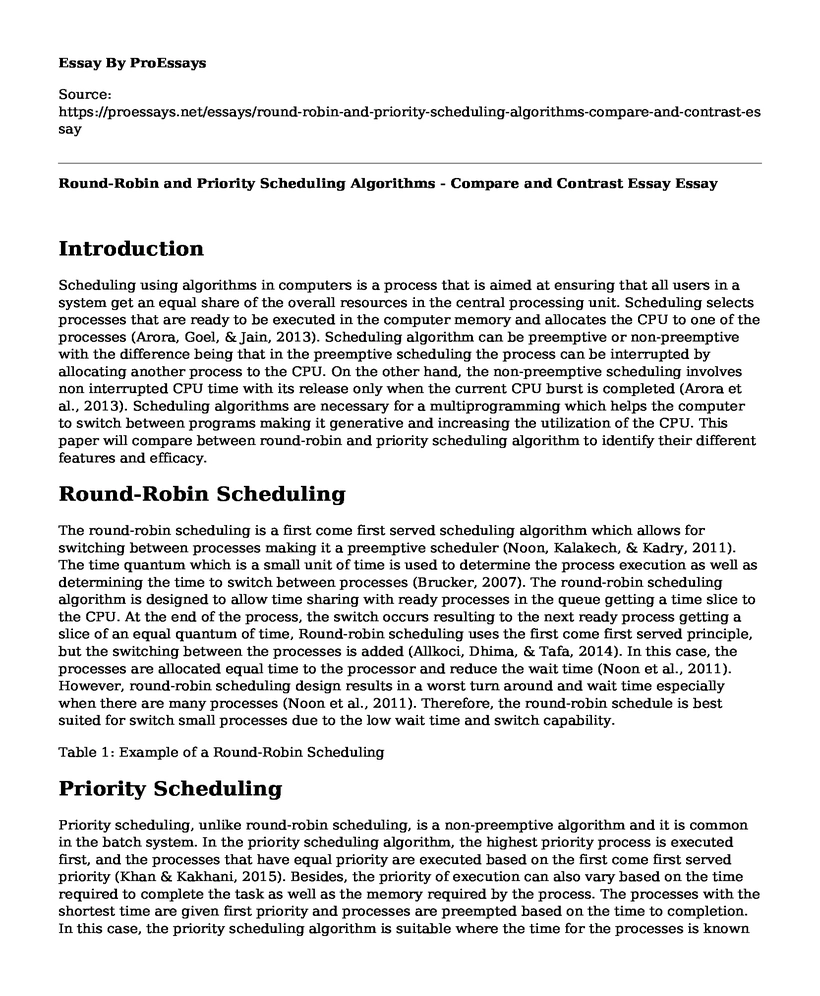Introduction
Scheduling using algorithms in computers is a process that is aimed at ensuring that all users in a system get an equal share of the overall resources in the central processing unit. Scheduling selects processes that are ready to be executed in the computer memory and allocates the CPU to one of the processes (Arora, Goel, & Jain, 2013). Scheduling algorithm can be preemptive or non-preemptive with the difference being that in the preemptive scheduling the process can be interrupted by allocating another process to the CPU. On the other hand, the non-preemptive scheduling involves non interrupted CPU time with its release only when the current CPU burst is completed (Arora et al., 2013). Scheduling algorithms are necessary for a multiprogramming which helps the computer to switch between programs making it generative and increasing the utilization of the CPU. This paper will compare between round-robin and priority scheduling algorithm to identify their different features and efficacy.
Round-Robin Scheduling
The round-robin scheduling is a first come first served scheduling algorithm which allows for switching between processes making it a preemptive scheduler (Noon, Kalakech, & Kadry, 2011). The time quantum which is a small unit of time is used to determine the process execution as well as determining the time to switch between processes (Brucker, 2007). The round-robin scheduling algorithm is designed to allow time sharing with ready processes in the queue getting a time slice to the CPU. At the end of the process, the switch occurs resulting to the next ready process getting a slice of an equal quantum of time, Round-robin scheduling uses the first come first served principle, but the switching between the processes is added (Allkoci, Dhima, & Tafa, 2014). In this case, the processes are allocated equal time to the processor and reduce the wait time (Noon et al., 2011). However, round-robin scheduling design results in a worst turn around and wait time especially when there are many processes (Noon et al., 2011). Therefore, the round-robin schedule is best suited for switch small processes due to the low wait time and switch capability.
Table 1: Example of a Round-Robin Scheduling
Priority Scheduling
Priority scheduling, unlike round-robin scheduling, is a non-preemptive algorithm and it is common in the batch system. In the priority scheduling algorithm, the highest priority process is executed first, and the processes that have equal priority are executed based on the first come first served priority (Khan & Kakhani, 2015). Besides, the priority of execution can also vary based on the time required to complete the task as well as the memory required by the process. The processes with the shortest time are given first priority and processes are preempted based on the time to completion. In this case, the priority scheduling algorithm is suitable where the time for the processes is known and also in the batch environment where the there is need to give preference (Kayande & Shrawankar, 2013). It is important to note that the priority algorithm shortcoming is the inability to give chance of executing the processes with lower priority especially where a large batch exists.
Reflection
There is a significant difference between the priority and the round-robin scheduling algorithm. The priority scheduling algorithm is preemptive, and the processes with the highest priority are given priority whereas the equal processes are given a first come first served execution basis. The round-robin schedule is suited for the systems that serve many clients and are based on the first in first out basis with every process being allocated an opportunity/equal share of time called quantum for execution. The priority scheduling is non-preemptive and priority, as well as the memory factor, are used in executing the processes. Therefore, the priority scheduler is fitted for self-regulating operating system, unlike the round-robin scheduler which can be used by multiple individuals.
References
Allkoci, A., Dhima, E., & Tafa, I.(2014). Comparing Priority and Round Robin Scheduling Algorithms. IJCSI International Journal of Computer Science Issues, 11(3).
Arora, H., Arora, D., Goel, B., & Jain, P. (2013). An Improved CPU Scheduling Algorithm. International Journal of Applied Information Systems, 6(6), 2249-0868.
Brucker, P., & Brucker, P. (2007). Scheduling algorithms (Vol. 3). Berlin: Springer.
Kayande, D., & Shrawankar, U. (2013). Priority-based pre-emptive task scheduling for Android operating system. arXiv preprint arXiv:1304.7889.
Khan, R., & Kakhani, G. (2015). Analysis of priority scheduling algorithm on the basis of fcfs and sjf for similar priority jobs. Int J Comput Sci Mob Comput, 4, 324-331.
Noon, A., Kalakech, A., & Kadry, S. (2011). A new round robin based scheduling algorithm for operating systems: dynamic quantum using the mean average. arXiv preprint arXiv:1111.5348.
Cite this page
Round-Robin and Priority Scheduling Algorithms - Compare and Contrast Essay. (2022, Nov 20). Retrieved from https://proessays.net/essays/round-robin-and-priority-scheduling-algorithms-compare-and-contrast-essay
If you are the original author of this essay and no longer wish to have it published on the ProEssays website, please click below to request its removal:
- Mobile Phone Forensics - Example of Writing Assignment
- Coal-Fired Power Took a Beating During the Pandemic Article Analysis
- Cyberstalking: Fraud, False Allegations & Threats - Essay Sample
- Data Breach: An Increasing Threat to Information Security - Essay Sample
- Essay Sample on Robotic Surgery: Improved Control, Flexibility & Precision.
- Essay Example on Data Security: A Growing Concern in Our Digital World
- NMR Spectroscopy: Introduction to Spin, Energy Levels and Radiation Absorption - Essay Sample







